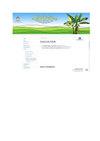为粮食安全和气候变化的全年生产成功地操纵了薯蓣(Dioscorea spp.)的生长周期
IF 0.3
Q4 AGRONOMY
引用次数: 1
摘要
Yam是整个加勒比地区的重要食物,其中,Dioscorea alata L.和D.esculenta(Lour.)Burkill这两个物种的品种在东加勒比和南加勒比尤为重要,尽管后者的重要性较小。这些品种的生长期约为九个月,并有相应的休眠期,每年都像钟表一样生产,一年中约有三个月可供食用,可用期与休眠期重合,因为休眠期标志着块茎的自然储存期。因此,休眠的打破标志着自然贮藏结束的开始,因为发芽的芽预示着下一个生长期的开始。这与雨季的开始不谋而合,这种山药适应了现有的气候条件,为植物的建立和块茎的生长提供了理想的环境。这两个物种的品种没有繁殖种子,因此完全依赖营养手段来维持。在储存或早期生长过程中,任何阻碍发芽或块茎萌生和生长的不利发育都会导致受影响材料的永久损失,并可能威胁到特定品种的损失。因此,气候变化事件,如雨季开始的变化、干旱期的延长以及与过度洪水相关的恶劣天气的发生,可能导致根系死亡和块茎发育,对加勒比地区生产的D.alata和D.esculenta品种的持久性构成了实际风险。为了抵消这些影响,需要的是操纵生长周期,以实现全年生产,从而使观察到的气候和天气模式的变化不会导致种植材料的损失,进而导致种质的损失。众所周知,生长周期处于激素控制之下,全年生产的关键是打破生长周期的生理锁定,而生长周期是这些物种的季节性生产特征。研究人员过去曾多次尝试实现这一目标,但直到最近都没有成功。大多数尝试都探索了使用天然和合成植物生长调节剂。此外,过去的尝试集中在打破自然休眠和诱导早期发芽上,但这里报道的成功是通过一种新的方法将发芽延迟到自然休眠期之后实现的,该方法消除了生长调节剂和其他化学物质的使用。本文报道了如何成功地利用低温贮藏来打破D.alata和D.esculenta品种的生理控制生长周期,通过推迟休眠的打破,全年生产出土豆,不仅确保了土豆块茎的可供食用性,而且确保了全年可供种植的材料的可用性。研究发现,块茎可以在整个周期内成功储存,因此前一年的块茎可以与当年收获的块茎相遇,从而为任何不利的生物或气候事件造成的作物损失提供缓冲。描述了对发芽模式的影响。为此目的使用低温储存的情况尚未报道,这一说法填补了有文献记载的山药休眠研究中的一个重要空白。本文章由计算机程序翻译,如有差异,请以英文原文为准。
Successful manipulation of the growth cycle of yam (Dioscorea spp.) for year-round production for food security and climate change
Yams are important items of diet throughout the Caribbean Region and, among them, the cultivars of the species, Dioscorea alata L. and D. esculenta (Lour.) Burkill are particularly important in the Eastern and Southern Caribbean, although the latter is so to a lesser extent. With a growing period of approximately nine months and a corresponding dormancy period, these cultivars are produced on an annual basis like clockwork, providing food yams for approximately three months of the year, the period of availability coinciding with the period of dormancy as the latter marks the natural period of storage of the tuber. Consequently, the breakage of dormancy marks the beginning of the end of natural storage as the emerging sprouts signal the onset of the next growing period. This coincides with the start of the rainy season and the yam is adapted to existing climatic conditions that provide the ideal environment for both plant establishment and tuber growth. Cultivars of the two species bear no reproductive seed and therefore, are completely dependent on vegetative means for perpetuation. Any adverse development during storage or early growth that prevents sprouting or tuber initiation and growth, results in the permanent loss of the affected material and potentially threatens loss of the specific cultivar. Hence, climate change events such as shifts in the onset of the rainy season, extension of the dry period and incidences of severe weather associated with excessive flooding that can result in death of roots and developing tubers, pose real risks to the persistence of the cultivars of D. alata and D. esculenta that are produced in the Caribbean Region. In order to counteract these effects, what is needed is the manipulation of the growth cycle to allow for year-round production so that the changes that have been observed with respect to climatic and weather patterns will not result in a loss of planting material and, by extension, loss of germplasm. It is well-established that the growth cycle is under hormonal control and that the key to year-round production is the breaking of the physiological lock on the growth cycle that is responsible for the seasonal production by which these species are characterized. There have been many attempts by researchers in the past to achieve this, but without success until relatively recently. Most attempts have explored the use of natural and synthetic plant growth regulators. Further, past attempts have focussed on the breakage of natural dormancy and induction of early sprouting, but instead, the success reported here, was achieved by delaying sprouting to beyond the period of natural dormancy in a novel approach that eliminates the use of growth regulators and other chemicals. This paper reports how reduced temperature storage has been used successfully to break the physiologically controlled growth cycle in cultivars of D. alata and D. esculenta, producing yams all year long by delaying the breakage of dormancy, ensuring not only an extension of the availability of yam tubers for food but also availability of viable planting material throughout the year. It was found that tubers can be stored successfully for an entire cycle, so that tubers from the previous year can meet tubers of the current year’s harvest providing a buffer against crop loss from any adverse biotic or climatic event. The effects on sprouting patterns are described. The use of reduced temperature storage for this purpose has not been reported and this account serves to fill an important gap in documented yam dormancy research.
求助全文
通过发布文献求助,成功后即可免费获取论文全文。
去求助
来源期刊

Tropical Agriculture
Social Sciences-Development
CiteScore
0.50
自引率
0.00%
发文量
0
期刊介绍:
The overarching aim of Tropical Agriculture is to contribute to the process of agricultural development in tropical agro-ecosystems, through publication of papers in the area of agricultural science and technology. The specific objectives of the Journal are: -To address the practical aspects of sustainable tropical agriculture production, improvement, protection and commodity utilization, worldwide. -To foster the application of science and technology to understanding and removal of constraints to tropical agricultural productivity. -To publish the results of original research which make significant contributions to knowledge on the practice of sustainable and productive tropical agriculture. The Journal publishes papers in the following areas of tropical agriculture: -Soil Science and Technology -Environmental Science and Technology -Crop Science and Technology -Livestock Science and Technology as well as: Food and Nutrition Policy, Post-Harvest Technology, Agricultural Economics and Extension, Agribusiness
 求助内容:
求助内容: 应助结果提醒方式:
应助结果提醒方式:


